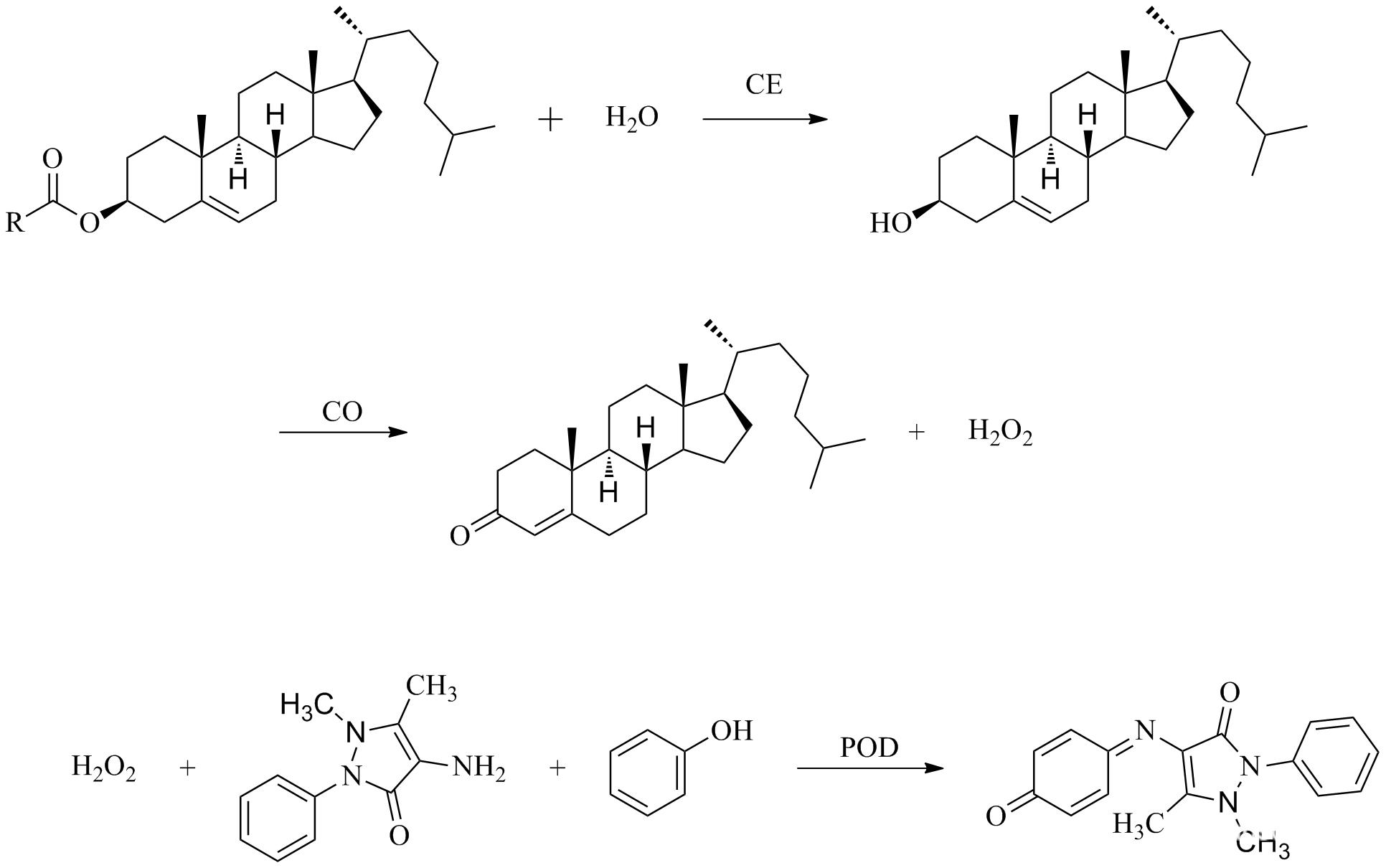Total Cholesterol (TC) Colorimetric Assay Kit (Single Reagent, COD-PAP Method)
SKU: E-BC-K109-M-500
Total Cholesterol (TC) Colorimetric Assay Kit (Single Reagent, COD-PAP Method)
| SKU # | E-BC-K109-M |
| Detection Instrument | Microplate reader(495-525 nm) |
| Detection Method | Colorimetric method |
Product Details
Properties
| Synonyms | TC |
| Sample Type | Serum, plasma, tissue |
| Sensitivity | 0.29 mmol/L |
| Detection Range | 0.29-25.85 mmol/L |
| Detection Method | Colorimetric method |
| Assay type | Quantitative |
| Assay time | 20 min |
| Precision | Average inter-assay CV: 8.300% | Average intra-assay CV: 3.100% |
| Other instruments required | Micropipettor, Incubator, Centrifuge |
| Other reagents required | Normal saline (0.9% NaCl), PBS (0.01 M, pH 7.4), Anhydrous ethanol |
| Storage | 2-8℃ |
| Valid period | 12 months |
Images
C Zhu et al found that TRIM64 can promote pyroptosis, foam cell formation and inflammation by activating NF-κB. Total cholesterol (TC) levels in human THP-1 cell was determined using TC colorimetric assay kit (E-BC-K109-M).

The concentration of cholesterol in THP-1 cell was significantly increased in ox-LDL group. (***P<0.001)
Dilution of Sample
It is recommended to take 2~3 samples with expected large difference to do pre-experiment before formal experiment and dilute the sample according to the result of the pre-experiment and the detection range (0.29-25.85 mmol/L).
The recommended dilution factor for different samples is as follows (for reference only):
| Sample type | Dilution factor |
| Human serum | 1 |
| Mouse serum | 1 |
| Rat plasma | 1 |
| 10% Mouse liver tissue homogenate | 1 |
| 10% Mouse kidney tissue homogenate | 1 |
| 10% Mouse heart tissue homogenate | 1 |
Note: The diluent is normal saline (0.9% NaCl) or PBS (0.01 M, pH 7.4) for serum (plasma) samples; The diluent is anhydrous ethanol for tissue samples.
Detection Principle
Total cholesterol includes free cholesterol and cholesterol esters. Cholesterol ester can be hydrolyzed by cholesterol esterase to produce cholesterol and free fatty acid. Cholesterol is oxidized by cholesterol oxidase to produce △4-cholestenone and hydrogen peroxide. In the presence of 4-aminoamylpyridine and phenol, hydrogen peroxide catalyze peroxidase to form red quinone compounds of benzoquinone imine phenizone. The color depth of the generated quinone is directly proportional to the cholesterol content. The absorbance values of the standard tube and the sample tube are measured respectively, and the cholesterol content in the sample can be calculated.

Kit Components & Storage
| Item | Component | Size 1(48 T) | Size 2(96 T) | Storage |
| Reagent 1 | Enzyme Working Solution |
15 mL ×1 vial | 30 mL ×1 vial | 2-8°C, 12 months, shading light |
| Reagent 2 | 5.17 mM Cholesterol Standard |
0.2 mL ×1 vial | 0.2 mL × 1 vial | 2-8°C, 12 months |
| Microplate | 96 wells | No requirement | ||
| Plate Sealer | 2 pieces | |||
Note: The reagents must be stored strictly according to the preservation conditions in the above table. The reagents in different kits cannot be mixed with each other. For a small volume of reagents, please centrifuge before use, so as not to obtain sufficient amount of reagents.
Technical Data:
Parameter:
Intra-assay Precision
Three human serum samples were assayed in replicates of 20 to determine precision within an assay. (CV = Coefficient of Variation)
| Parameters | Sample 1 | Sample 2 | Sample 3 |
| Mean (mmol/L) | 2.50 | 16.80 | 22.00 |
| %CV | 3.3 | 3.2 | 2.8 |
Inter-assay Precision
Three human serum samples were assayed 20 times in duplicate by three operators to determine precision between assays.
| Parameters | Sample 1 | Sample 2 | Sample 3 |
| Mean (mmol/L) | 2.50 | 16.80 | 22.00 |
| %CV | 8.0 | 8.3 | 8.3 |
Recovery
Take three samples of high concentration, middle concentration and low concentration to test the samples of each concentration for 6 times parallelly to get the average recovery rate of 103%.
| Standard 1 | Standard 2 | Standard 3 | |
| Expected Conc. (mmol/L) | 4.5 | 16.7 | 20.5 |
| Observed Conc. (mmol/L) | 4.6 | 17.5 | 20.9 |
| Recovery rate (%) | 102 | 105 | 102 |
Sensitivity
The analytical sensitivity of the assay is 0.29 mmol/L. This was determined by adding two standard deviations to the mean O.D. obtained when the zero standard was assayed 20 times, and calculating the corresponding concentration.
Standard Curve
As the OD value of the standard curve may vary according to the conditions of the actual assay performance (e.g. operator, pipetting technique or temperature effects), so the standard curve and data are provided as below for reference only
| Concentration (mmol/L) | 0 | 1.29 | 2.58 | 5.17 | 10.34 | 15.51 | 20.68 | 25.85 |
| OD value | 0.054 | 0.100 | 0.160 | 0.267 | 0.467 | 0.685 | 0.928 | 1.155 |
| 0.053 | 0.102 | 0.166 | 0.265 | 0.469 | 0.683 | 0.928 | 1.159 | |
| Average OD | 0.054 | 0.101 | 0.163 | 0.266 | 0.468 | 0.684 | 0.928 | 1.157 |
| Absoluted OD | 0 | 0.047 | 0.109 | 0.212 | 0.414 | 0.630 | 0.874 | 1.103 |



